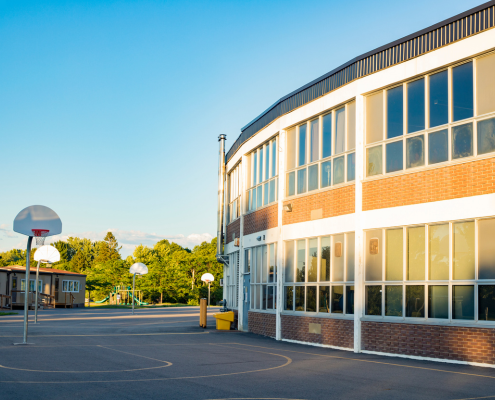November 3, 2025
Share this post
As school buildings in North America grapple with aging infrastructure and mounting associated costs, districts must make critical decisions about how to address these challenges. Retrofitting existing buildings offers a sustainable, cost-effective, and environmentally responsible solution. This approach not only meets immediate needs but also ensures long-term savings and aligns with decarbonization goals, creating resilient, energy-efficient learning environments.
One of the primary advantages of retrofitting is its potential for significant cost savings. With supply chain constraints, labor challenges, and contractor schedules, it’s generally less expensive and more time-sensitive to alter and rehabilitate an existing school rather than build a new one. Moreover, financial benefits extend beyond initial construction costs: retrofitted schools can achieve dramatic reductions in energy consumption, translating to substantial ongoing savings. The U.S. Green Building Council estimates that green schools could save as much as $100,000 annually, with about half of that coming from reduced energy costs alone.
Energy efficiency and emissions reduction targets
Retrofitting also aligns closely with decarbonization goals for the built environment. A study by the Preservation Green Lab found that building reuse is more likely to offer environmental savings compared to new construction, as it involves less power consumption and reduces CO2 emissions. This approach to K-12 decarbonization can have a substantial impact when implemented across an entire school district.
Energy efficiency is at the heart of sustainable school retrofits. By upgrading lighting, heating, and insulation systems, schools can dramatically improve their energy performance. Replacing outdated lighting with energy-efficient LED systems can significantly reduce electricity consumption, while enhancing insulation and upgrading HVAC systems can lead to better temperature control and reduced energy waste. These improvements not only lower operating costs but also create healthier learning environments. By implementing improved ventilation systems, using the latest non-toxic materials, and enhancing natural lighting, schools can contribute to improved indoor air quality and overall student and staff well-being. Such comprehensive upgrades can potentially reduce absenteeism and improve academic performance, demonstrating that eco-friendly school upgrades have benefits beyond just environmental impact.
Renewable opportunities
Integrating renewable energy into school campuses can further accelerate decarbonization efforts while making schools more resilient. On-site solar installations can offset a significant portion of a school’s energy needs, demonstrating sustainability in action to students and the community. For schools without the space for on-site generation, renewable energy programs like community solar or power purchase agreements (PPAs) provide flexible options to transition to clean energy.
Pairing renewable energy systems with battery storage further enhances their value, ensuring a steady power supply during outages and reducing reliance on fossil fuels. These systems not only make schools more energy-independent but also safeguard operations in emergencies, keeping students safe and learning uninterrupted.
Financial considerations
Financing these retrofits is often a major concern for school districts, but various options are available. Many states offer financing mechanisms such as bond issuance to fund school construction and renovation costs. Additionally, schools can leverage a combination of federal and state resources, internal financing, debt financing, leasing arrangements, and Energy Savings Performance Contracts (ESPCs). Innovative financing models like on-bill financing, where retrofit costs are repaid through utility bills, and commercial property-assessed clean energy (C-PACE) funding offer alternatives for schools looking to implement green initiatives without significant upfront costs.
As we move towards a more sustainable future, the role of schools in community resilience becomes increasingly important. Retrofitted schools, with their improved energy efficiency and potential for renewable energy integration, often serve as community hubs during emergencies, providing shelter, power, and resources when needed, enhancing overall community energy resilience.
Next steps for driving infrastructure improvements
By focusing on energy efficiency, renewable energy integration, and creating healthier learning environments, school districts can transform their aging buildings into modern, sustainable facilities. A retrofit approach not only addresses immediate infrastructure needs, but also contributes to the larger goal of decarbonizing education and creating a more sustainable built environment.
While the challenge of updating schools is significant, retrofitting offers a sustainable, cost-effective solution that aligns with broader environmental goals. There are great guides to help schools navigate these steps, such as Ameresco’s Decarbonization Planning Guide. As we look to the future, smart school retrofits and low-carbon school solutions will play a crucial role in shaping the next generation of learners and leaders in a world increasingly focused on sustainability and environmental responsibility.
This free resource provides a tangible roadmap for organizations looking to reduce their carbon footprint and achieve net zero emissions. The built environment is responsible for roughly 40% of energy-related carbon emissions. This resource offers a holistic approach to cutting consumption, costs, and carbon and practical solutions for facility owners and operators.



